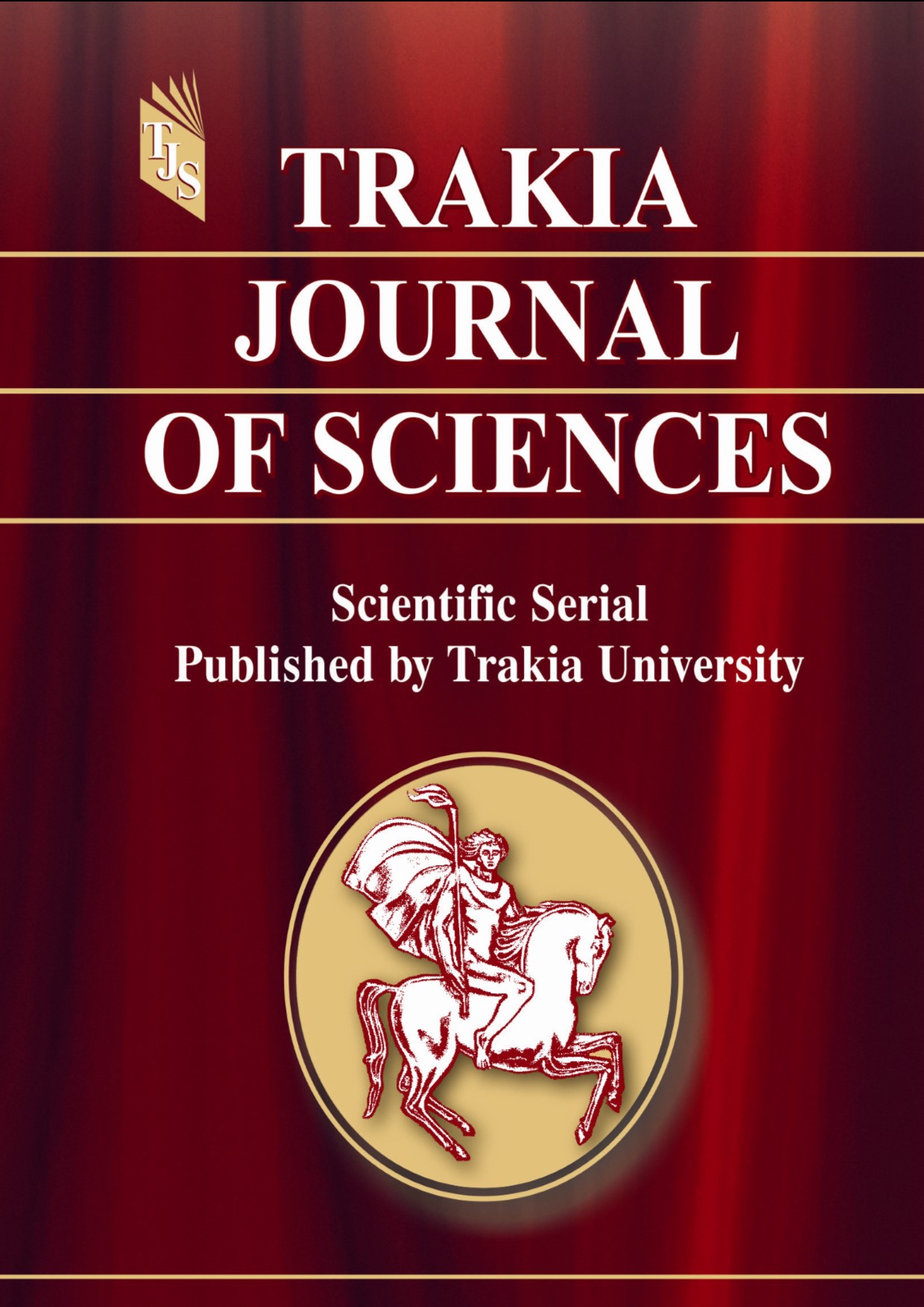STUDY ON ANIMAL BONE MATERIAL EXCAVATED FROM AN ARCHEOLOGICAL SITE FROM THE EARLY CHALCOLITH AND THE LATE IRON AGE NEAR THE VILLAGE OF SREDETS, BULGARIA
DOI:
https://doi.org/10.15547/tjs.2024.04.004Keywords:
osteoarcheology, animal bone artefacts, Early Chalcolithic Age, Late Iron Age, archaeozoology, BulgariaAbstract
The aim of the present research was to perform an archaeozoological analysis of animal bone material obtained from excavations near the village of Sredets, Stara Zagora region, Bulgaria. The osteoarchaeological finding was species-determined by morphological methods. The osteological material contained an entire skeleton of a sacrificed horse and 1015 species-determined bones and bone fragments belonging to a total of nine species of mammals of domestic and wild origin. The osteological finding from domestic mammals was predominant, amounting to 941 pieces of bones. The cattle bones took up a leading position of the total number of identified bones – 49,80% from the Early Chalcolithic Age and 58,14% from the Late Iron Age. The greater part comprised food remains from ancient inhabitants, indicated by the strong fragmentation of the animal bones, and traces of a mechanical impact as a result of an interaction with hard objects (portioning), as well as traces of thermal processing (burning). In a ritual pit from the Late Iron Age, a skeleton of a sacrificial horse was found. The horse was part of the livelihood and economic activity in these lands, marked the high social status of its owner, and, therefore, was sacrificed during funerals or other rituals.
References
Balevska, R.; Petrov, A. Nomenclature and systematics of the wild and history of the pre-domestic animals in our lands. Publisher: BAS, Sofia, Bulgaria, 1968; pp. 175.
Vasilev, V. Osteological, osteometric and comparative studies on the animal bone material from the prehistoric habitation tumulus near the village of Ovhcarovo. PhD Thesis, BAS, Sofia, 1981.
Vladova, D.; Kostov, D.; Dechev, A.; Dimitrov, R.; Hristov, H. Osteological studies on the bones of domestic animals from the archeological site “Cherna gora-1”. Bulgarian Journal of Veterinary Medicine, 4, (Suppl. 1), 1-6, 2001.
Gromova, V. Osteological Differences between the Genera Capra (Goats) and Ovis (Sheep). Tr. Komis. Izuch. Chetv. Perioda, , 10 (1), pp. 125, 1953.
Ivanov, S.; Vasilev, V. Studies on animal bone remains. In Ezero. Early Bronze Settlement; G. Georgiev, N. Merpert, R. Katincharov, D. Dimitrov Eds.; Sofia, Bulgaria, pp. 425-481, 1979.
Ivanov, S.; Vasilev, V. Studies on the animal bone material from the prehistoric tumulus near Golyamo Delchevo. BAS, Sofia, 1975; pp. 245.
Ivanov, S.; Vasilev, V. Studies on animal bones from the Early Bronze settlement “Ezero”, BAS, Sofia, 1979; pp. 425.
Kovachev, G. Domestic animals from the prehistoric settlement near Rakitovo. Zhivotnovadni nauki, XXII, 8, 50-57, 1985.
Kostov, D., Study on animal bone material from prehistoric Neolithic settlements near the District Hospital of Stara Zagora. Project 09/07; Faculty of Veterinary Medicine, Trakia University, Bulgaria, 2007; pp. 125.
Ninov, L., Domestication and osteological changes in the pig. Annuary of the Department of Archeology, NBU, Sofia, II-III, pp.187-193, 1996.
Spasov, N.; Iliev, N.; Boev, Z. Animal remains from the Eneolithic archeological site near the village of Dolnoslav, Plovdiv region. Historia naturalis Bulgarica, 13, 159-179, 2001.
Byers, D.; Broughton, J. Holocene environmental change, artiodactyls abundances, and human hunting strategies in the great basin. American Antiquity, 69, 235-256, 2004.
France, D.L. Human and Nonhuman Bone Identification: A Color Atlas, 1st ed. CRC Press, 2008. https://doi.org/10.1201/9781420062878
Tsalkin, V. Metapodial variation and its significance for the study of ancient Horned Cattle (in Russian). Bulletin of Moscow Society of Naturalists, Biological Series, V, 65(1), 109-126, 1960.
Tsalkin, V. The variability of metapodia in sheep (in Russian). Bulletin of Moscow Society of Naturalists, Biological Series, V, 65(5), 115-32, 1961.
Boessneck, J. Osteological differences between sheep (Ovis aries Linné) and goat (Capra hircus Linné). In Science in archaeology, 2nd ed.; Brothwell D. R., Higgs E. S., Eds.; Publisher: Thames & Hudson, London, pp. 331-358, 1969.
Simon, J. The Archaeology of Animals, 1st ed.; Routledge, London, 1987; pp. 228. https://doi.org/10.4324/9780203060131
Kratochvil, Z. Species criteria on the distal section of the tibia in Ovis amonf. Aries L. and Capra aegagrus f. hircus L., Acta Veterinaria Brn, 38, 483-490, 1969.
Hegner, D., Zur Morphologie der Ethmoturbinalia von Ovis aries und Capra hircus. Berl. Munch. Tierarztl Wochenschr 75, 445-447, 1962.
Schramm, Z. Róznice morfologiczne niectirych kosci kozy i owci. Roczniki Wyźsej Szkoly Rolniczej w Poznaniu, 36, 107-1351967.
Halstead, P.; Collins P.; Isaakidou, V. Sorting the sheep from the goats: morphological distinctions between the mandibles and mandibular teeth of adult Ovis and Capra. Journal of Archaeological Science, 29, 545-553, 2002
Gurskii, I. Age determination in the woolf (Canis lupus) by the skull. Vest. Zoology, 3, 55-59, 1973.
Bökönyi, S. A new method for the determination of the number of individuals in animal bone material. American Journal of Archaeology, 74, 291- 292, 1970.
Behrensmeyer, A. Taphonomic and ecological information from bone weathering. Paleobiology, 4, 150-162, 1978.
Bogolyubsky, S. The origin and evolution of domestic animals (in Russian). Publisher: Soviet Science, Moscow, 1959; pp. 593.
Kovachev, G. Animal bones from a prehistoric settlement and Thracian mound necropolis near the village of Kalugerovo. Agricultural Academy, Animal Sciences, XXIII, 60, 1986.
Spassov, N.; Iliev, N. Animal Remains from the Submerged Late Eneolithic – Early Bronze Age Settlement Near Sozopol (The South Black Sea Coast of Bulgaria). Tracia Pontica, Proceedings of the Internatioanal Symposium Thracia Pontica, 6, pp. 287-314, 1994.
Kostov, D.; Vladova, D. Study of animal bone material from the mound necropolis "Triangle" near the town of Nova Zagora. Bulgarian Journal of Veterinary Medicine, 12, (Suppl. 1), 11–18, 2009.
Ivanov, S. Domestic and wild animals in the household of the population from Yasatepe in Plovdiv. Archaeological Museum, Plovdiv, III, pp. 81-114, 1959.
Kovachev, G. Wild and domestic animals from the Neolithic settlements near
Kazanlak, Rakitovo and Kalugerovo. Osteoscopic and osteometric studies. PhD Thesis, VIZVM, Stara Zagora, 1988.
Gündem, C.Y. Earliest Mule Remains from Early Bronze Age Central Anatolia. Animals, 14, 1397, 25024. https://doi.org/10.3390/ani14101397
Nehring, A. Uber Riesen und Zwerge des Bos primigenius. Sitsungs – Bericht der Gesellschaft naturforschender Freunde. I. Berlin, 1989.
Duerst, J. Animal Remains from the Excavations at Anau, and the Horse of Anau in its Relation to the Races of Domestic Horses. In Explorations in Turkestan. Prehistoric Civilizations of Anau: Origins, Growth, and Influence of Environment. R.W. Pumpelly Ed., Washington, 2, 341-446, 1908.
Forsten, A.; Dimitruevic, V. Pleistocene horses (genus Equus) in the central Balkans. Anales geologiques de la Pennsule Balkanque, 65, 55-75, 2002.

Downloads
Published
Issue
Section
License
Copyright (c) 2024 Trakia University

This work is licensed under a Creative Commons Attribution-NonCommercial 4.0 International License.


